We’ve been eating a lot of fermented vegetables lately. We started with kimchi (Homemade Kimchi, Jun 26, 2011), but lately we’ve been fermenting our vegetables in a less spicy style that is normally used for sauerkraut.
“Sauerkraut” means “sour cabbage.” We are not huge cabbage fans, so we often substitute other vegetables. We’ve had good results from Daikon radish, red radish, carrot, celery, and cabbage; the only vegetable we didn’t care for was parsnip.
This is a really simple procedure – mix salt, water, and vegetables with a few spices; leave in a cool, dark sealed container for 7-10 days; eat.
For safety, the key is to give enough time for the water to become acidic. Wikipedia explains the evolution of the bacterial population:
The fermentation process has three phases. In the first phase, anaerobic bacteria such as Klebsiella and Enterobacter lead the fermentation, and begin producing an acidic environment that favours later bacteria. The second phase starts as the acid levels become too high for many bacteria, and Leuconostoc mesenteroides and other Leuconostoc spp. take dominance. In the third phase, various Lactobacillus species, including L. brevis and L. plantarum, ferment any remaining sugars, further lowering the pH. There are unpasteurized sauerkrauts on the market. Properly cured sauerkraut is sufficiently acidic to prevent a favorable environment for the growth of Clostridium botulinum, the toxins of which cause botulism.
Klebsiella and Enterobacter are potentially pathogenic bacteria, but the later Leuconostoc and Lactobacillus species are probiotic. So the more acidic the water, the better the mix of bacteria.
Another good tactic is use predominantly low-calorie vegetables. Keeping sugar levels low will help keep the yeast population down.
First Batch: Daikon radish, celery, carrot
Here were the raw materials for one batch:
We could have cut the white Daikon radish pieces smaller, but this size did fine: by day 7 they were softened all the way through.
Sea salt, ginger, garlic, and peppercorn are seasonings we consider essential; green onion and red pepper have worked for us as well.
You’ll need a large glass or ceramic container that seals. If it is glass, keep it in a dark cabinet while fermenting to avoid light exposure. We like to look at ours in progress, so we bought glass containers.
Fill the glass container about 80% full with diced vegetables, then cover with water so the container is 90% full. Add enough sea salt that the water tastes salty, but not undrinkably so. Also add the other seasonings – ginger, garlic, peppercorn, and any others you choose.
The container will now look like this:
Now it has to be covered with an air-tight seal. We placed plastic wrap over the top, wrapped a rubber band around the jar, and then sealed the lid over the wrap:
After a week it will look like this:
Note how cloudy the water has become.
After a week you should be able to start removing vegetables to eat. Here are some vegetables:
It’s also a good idea to remove the cloudy fluid and drink it. This makes a great “soup” or beverage along with your meal.
As you remove fluid, add water and sea salt to replace what you took. When you run out of vegetables, add a new batch of diced vegetables to the old fluid and let it ferment for a week.
Second Batch: Daikon radish, green onion, and red radish
This first try was so successful we bought a larger glass container and made another batch, this time including red radish. Ingredients:
Here it is ready to go into a dark cabinet for fermentation:
And here it is a week later:
All the red skin pigment has come off the radishes and into the fluid. Here is a bowl of vegetables and fluid:
We’ve been eating two bowls a day, one at dinner and the other at breakfast or lunch.
Other Tips
Try to keep the fermentation jar sterile. We replace the wrap every time we open the container, and keep the lid region dry at all times: if any fluid spills on it as we take vegetables out, we dry the top of the jar with a paper towel. (Bacteria need moisture to thrive.)
If you have concerns about the bacteria on your vegetables, sprinkle salt over them and let them sit for a bit, then rinse the vegetables before dicing them and adding them to the container. This salting will help sterilize the surface a bit.
Conclusion
Even if you don’t like vegetables, you’ll probably like this. Fermented vegetables are surprisingly tasty. Moreover, the fluid is also very tasty. It makes a healthful hydrating beverage, and a great accompaniment to a meal; the acidic fluid helps clear the palate and improve the taste of foods.
We couldn’t be happier with our vegetable fermentation. It makes vegetables taste great, provides us with helpful probiotic flora and lactic acid, and is exceptionally easy to prepare. No cooking necessary!







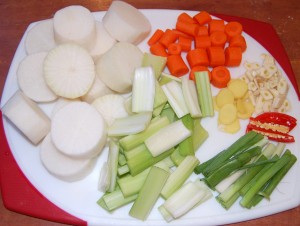
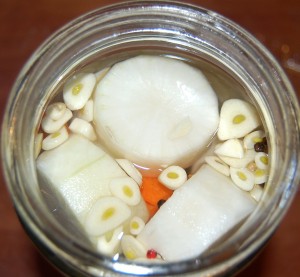

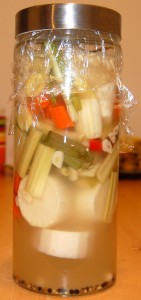
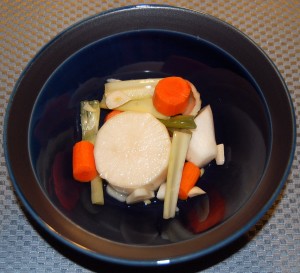
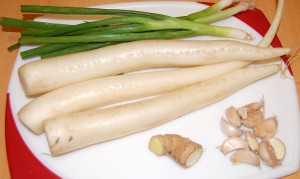
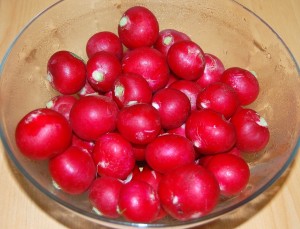
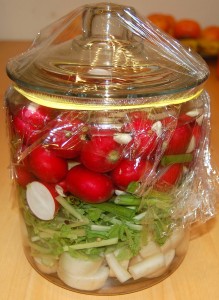
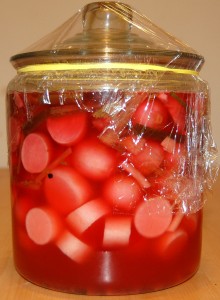
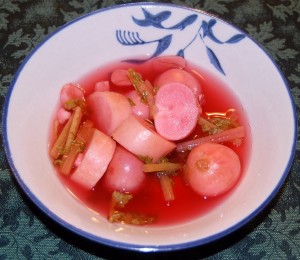




HI there, thanks for this.
I’ve made pickles sometimes with vinegar — umeboshi plum vinegar being my favorite. Do you think a pickle made with vinegar would ferment the same way and have the same benefits as one made with salt?
I also do a pressed salad which is a wonderful way to eat salads for people like me who normally don’t like raw lettuce and vegetables. it’s basically a fast pickled salad — you use crispy lettuce or cabbage and crispy vegetables like radishes, onions, fennel, carrots, and massage the salad with about a teaspoon or so of salt or vinegar and then press it for an hour or so before you eat it. I don’t imagine it ferments in that short time, but the vegetables are much more palatable after this. And you don’t have to put any dressing on it.
elizabethe, preserving with vinegar, while tasty, is very different than fermenting with salt. The fermentation process produces beneficial bacteria which helps with so much.
My favorite ferment so far is sliced carrots with lots of ginger. I just bought cauliflower to experiment with. Yum.
Great recipe! I recently made sauerkraut at home, but this looks so much prettier and I bet its even tastier 🙂 I will give it a try!
If you like pickled radish and daikon, I bet you will like pickled turnip. I use the medium grating blade of my food processor to shred either turnip or radish for making my pickles.
When I tried to pickle shredded carrots or beets they always got slimy. So I came up with a few other tactics:
I mixed shredded beets with shredded daikon and pickled the mixture. That worked very well.
Instead of pickling the carrots I make my favorite shredded carrot salad with some salt, good olive oil and either vinegar or lemon juice and keep it in the fridge. I toss that with pickled radish either right before serving, which makes a nice contrast of fresh and pickle or in a larger amount to store in the fridge for a few days to slightly pickle the carrots.
Will have to try some of your chunky mixtures. They look yummy.
If you’re interested in fermented plant foods I recommend the book “Wild Fermentation” by Sandor Ellix Katz.
http://wildfermentation.com/
Hi Elizabeth,
Vinegar and vegetables are healthy foods, so this is a healthy way to eat, but give fermenting a try too.
Hi Ellen,
Carrots and especially beets are sugary so you have the problem that yeast will grow.
The slimy surface coating you mention is probably yeast/fungus.
One way to help reduce this is to salt them heavily, and let them sit with the salt coating for a while before putting the vegetables in the pickling solution. The most important way is to deprive the ferment of oxygen – fill the container so it has only a tiny pocket of air, seal it so no air can enter, and don’t open the container while it is fermenting. But given that you’ve complained of fungal infections, you might want to avoid fermenting the sugary vegetables, and stick to that shredded carrot salad which sounds yummy!
Hi Andre,
It’s on our reading list! I’ve heard it’s essential reading.
What do you think about ‘colonizing’ with a little kefir whey?
Thanks for the fermenting ideas.
I seem to recall once reading about research that indicated potential health problems from frequent consumption of fermented vegetables. It might even have been on your site. But now I can’t find a reference anywhere. Any ideas?
My recollection is that the findings were probably confounded with other variables. But I ask because we ferment at our home so often now that I want to dispel the lingering suspicion.
Hi Ezer,
Because of my history of fungal issues I’m cautious about anything that has a yeast ferment.
Hi Syz,
There are high rates of stomach cancer in Korea which has been attributed to fungal toxins from fermented vegetables.
They tend to ferment kimchi for long periods of time — often for months, often speed the ferment by adding sugar, and often don’t seal the containers which allows oxygen. All of these practices support fungal growth.
Overall, I think the health balance greatly favors fermented vegetables, and the Asian countries are among the healthiest in the world overall. But good fermentation practices can reduce the risk dramatically.
The most important fermentation practices for safety in our view:
1. Airtight fermentation. Don’t give it much oxygen.
2. Appropriate time – 7-10 days is probably best – don’t ferment either too long or too short.
3. Don’t add sugar and use a mix of vegetables that is mostly low in sugar.
4. Cleanliness – keep the container sterile.
I’ve played around with a variety of vegetable ferments; ultimately I decided I like old fashioned sauerkraut the best. I use 5 lbs of cabbage to 3 tablespoons of sea salt, pound it down in my Harsch crock (expensive, but clever). Works great. Ellen, I have made beets successfully using Sally Fallon’s instructions to cook first and slice, not grate (releases fewer sugars). Re Wild Fermentation, my son and some of his college age friends decided to make the Incan spit beer in that book this summer. They had a lot of fun, even if the result was decidedly underwhelming.
Thanks, Paul. Very helpful. If sugar is a no-no, then what about the traditional pear in kim-chi — bad too?
Paul,
You mentioned you avoid kefir because of a history of fungal issues. I’ve always been a bit confused by this. When a person has bacterial issues, e.g. an overgrowth of “bad” bacteria, it’s suggested to use probiotics, or “good” bacteria to help combat it, the theory being that the good bacteria will keep the bad bacteria in check. Why wouldn’t this be the same for yeast? Aren’t the yeasts in kefir and kombucha, for instance, beneficial? And wouldn’t they help keep the harmful yeasts in check? I’d love to hear your thoughts on this.
I have been eating fermented veggies all my life since my family eats it for generations. I tried your kimchi recipe, and sorry to say, it was not a hit , to put it mildly, – cabbage was too soft, not particularly tasty in general. I routinely make sauerkraut, fermented cucumbers, tomatoes, eggplants, recently added to it fermented salsa. I just want to add some tips from my experience.
-It is better to add some carrots when you prepare fermented cabbage
(one or two carrots per one cabbage head), and nothing else, but salt.( Use salt with iodine, because iodine can inhibit fermentation.) When it is ready, let it stand in a refrigerator for couple of weeks – taste will be better developed.
-It is important to ferment veggies in relatively cool place, or brine may be bitter. I leaned it when I was making sourdough bread.
-Fermentation occurs faster if you use some leftover brine as a starter. It doesn’t matter if brine comes from different fermented dish. I usually keep some starter brine in my fridge.
-It is possible to ferment cooked veggies, like eggplants. Fermented eggplants should be cooked first in salted water, then some sauteed in olive oil carrots and onions are added inside of each eggplant through long-wise cut, raw garlic and celery are added, all get placed tightly in a jar, starter is added.
-Fermented veggies are very good in winter salads. Here is the example – If you combine medium cooked beet (or contains of 1 can of canned beets, drained), medium cooked potato, one cooked carrot, 3 pickles (or 1 cup of minced sauerkraut), half of raw onion, one finely chopped celery stick, add some brine and olive butter or mayonnaise, you will get great side dish. It could be used as a potato salad substitute.
-It is possible to mix raw things with fermented. For example, sauerkraut is much better mixed with raw finely chopped apple, green or sliced onion and olive oil.
Hi Syz,
Yes, I would avoid the pear. It does speed up fermenting so you can eat the kimchi quicker. But it makes it go bad quicker too, and overall I think it detracts from both taste and healthfulness.
Hi Debra,
The big difference between bacteria and fungi is that we need probiotic bacteria to be healthy, but I’m not aware of evidence that we need probiotic fungi.
I know that standard opinion in the fermented community believe that yeasts in kefir and kombucha are beneficial, and they are for some people – especially those with a bacterial dysbiosis. But I’ve also known cases of people with severe Candida infections developing fungemia after supplementing with Saccharomyces boulardii. Adding any yeast to an existing fungal population will allow gene exchange and will add to the fungal burden. All fungi have ways of suppressing immune response to their benefit, and this will tend to promote growth of all fungal species, not just the one you’re supplementing. So I think there are risks to these ferments.
So I think the “beneficial” yeasts will tend to keep harmful bacteria in check, but not harmful fungi. Whether they are beneficial overall depends on one’s personal situation.
I was very happy to find this post, as I just recently heard about the high rates of stomach cancer in Japan, which indeed made me wonder – and now I got my answer!
I am really thinking of trying some fermentation again; such a convenient food!
Also, thank you very much, Galina, for your helpful post!
Hi Galina,
Thanks for the tips! We’re just learning.
Coincidentally, I have just started experimenting with fermentation and so I am very happy to read this post! I have been using mason jars. Is the seal strong enough without using the plastic at the top or should I be using plastic?
Thanks!
Lisa
An airlock system works great for fermenting veggies. You can get a jar with an airlock at this site http://www.culturesforhealth.com/natural-fermentation/fermentation-crocks.html or go to a beer brewing place for the airlock and lid and make your own. Once the vegetables are in, you don’t have to worry about stirring, checking for mold, etc. Easy peasy! The one thing I’ve noticed though is that it tends to work best if you only fill the jar about 3/4 or so full because it will expand with the fermentation bubbles.
“Adding any yeast to an existing fungal population will allow gene exchange and will add to the fungal burden”
Sorry to be dense, but I don’t understand this. I think you said something similar when we were talking about vinegar.
Also, I would assume you do not think that the inclusion of
Saccharomyces_cerevisiae in a probiotic formula would be a good thing. It is part of Dr. Ron’s Ultra Pure, which he says is a good fungus helpful in fighting bad fungus. I was taking it but have stopped based on your point of view. Are there any good studies on either side of this question?
As regards, kefir and kombucha, my exerience says you are correct. It took a while, but consuming them on a regular basis over several months brought about negative results for me.
Hi all,
Thanks for all of the tips.
I use store bought Kimchi (I think it is made by a small local company), that I store in my fridge. Should I add water to the jar after I remove some kimchi, to keep the vegetables submerged? (I’ll be making my own soon.)
Thanks.
–Jim
Hi Lisa,
Mason jars are good. We prefer to be “safe than sorry.” Shou-Ching is an experimental biologist and if you’re exceedingly careful at every step, the experiments become more reproducible. Fermenting is like doing experiments in the biology lab – they’re living things and if you don’t control everything, differences can pile up fast. So it’s more a philosophy than data … but we would use wrap in addition to the lid.
Hi Angie,
They do work great, but are a bit expensive.
Hi Ellen,
My two ideas are:
1) There is a stereotypical immune response which is the same to all fungi. Any fungi that has evolved a way to suppress will therefore suppress immunity against all other fungi as well. Thus, any yeast/fungus that is well adapted to living within a human being (“probiotic” or not) will tend to induce the immune system to tolerate fungi in general.
2) Fungi can exchange genes. Thus, introducing a new species to a fungal infection will increase genetic diversity. This increases the likelihood that the fungi will find a combination of genes that allows them to create a more successful infection. It accelerates their “evolution” within you, helping them become better adapted to their new living environment – you.
There is very little literature on this. It’s hard to study infections in vivo and fungal infections get little clinical study. So we have to use judgment, anecdotal reports, and biology. I could be wrong, but I think this is the most likely way things are.
Yes, I would avoid Saccharomyces cerevisiae as well. It might help, but I consider it gambling and there’s more downside risk than upside, if odds of recovery by other means are high.
Best, Paul
Hi Jim,
If you like drinking the fluid, then adding water will give you more to drink. But diluting the acid might allow less desirable bacteria to multiply. I think it’s not bad to keep the vegetables covered, but I wouldn’t add more than that.
Im confused. In some recipes they advice to keep the jar open so oxygen can move out. They actually say that the jar will explode othervise. Has this happened to anyone here? I will still give Pauls recipe a try, an open jar last time didnt start the frementation process at all.
Thank you Paul, that was really helpful….those sneaky fungi!!!! At this point I don’t think I can be too careful, so I am always on the lookout for ways to fine tune what I am doing. And all these little tweaks seem to be making a difference.
You recommend only fermenting for 10 days. Which is usually what I do. But then I store them in the fridge until they are eaten, which may take a while because I usually pickle things from our garden and they all are ready at once.
Do you see a problem with keeping the ferments for several months in the fridge?
http://www.pickl-it.com/
these are pricey, but seem to be failure proof and the little ones are cute!
Hi Ville,
The fermentation does create gas and that’s why you need to leave an air pocket in the jar. But about 10% of the volume for air seems to be enough. We haven’t had any exploding jars.
Hi Ellen,
I think it’s fine to refrigerate them, and they should last quite a while if refrigerated. I don’t know exactly how long. I would watch for the taste to change.
PS – Great find! Those pickl-it jars look just right. The price seems reasonable.
Ville,
An air lock system will let the bubbles out but keep any airborne bad guys from getting in.
See my link above and Angies, earlier.
Also there is the Harsch crock.
I bought a fermentaion crock and followed the directions that came with it. The directions said the fermentation will take at least 4 weeks. It has been three but I haven’t opened it yet because I don’t want to break the seal. After reading this post I am wondering if 4-5 weeks is too long. Anyone have any thoughts on this?
Kate,
Thanks. I never did try Sally’s recipe for pickled beets because it didn’t seem to make sense to me to pickle something that had been cooked.
Now that I understand about the yeast problem, I think I will just forget about pickling beets and stick with my favorite cooking method: roasting with the skin on and wrapped in foil, then peeled and sliced and tossed with butter or marinated for a salad.
Perfect timing, but alas not enough time. I’m just going to have to marinate some vegetables for a meal I have planned tomorrow – it’s a copy of a dish from one of my favourite Chefs, Sat Bains: http://www.britishlarder.co.uk/restaurant-sat-bains-organic-salmon-miso-caramel-nettle-juice/
No miso in my dish, and I’ll have to think of a contrasting colour and texture, but mine will be nettle and guacamole, gently poached wild salmon and pickled vegetables – palm hearts, cauliflower, radish, cucumber and some fine herbs.
I’ll make sure I cut up too much and get some pickling properly. Looks like fun!
Wow, it looks appetizing, Paul. But the ratio of food to plate area seems very small!
That’s fine dining … my home dining version will be a proper meal.
I’ll also be doing a starter of daikon rosti, spinach and poached egg, and some kind of double cream and berry dessert – panna cotta, probably, so there’s plenty of good food there to make up a full meal.
I’m looking forward to the pickling!
Paul,
1. Can a probiotic capsule be opened and used as a starter for fermented veggies?
2. Slightly OT from the original post, but following up on some of the comments: do you feel that medicinal mushrooms (reishi, chaga, cordyceps, etc.) are also risky when there is a possible fungal infection?
Thanks so much.
thanks for the explanation of bacteria.
ok, i’m really sloppy by your standard.
i just use a canning jar. I napa cabbage (washed & dried) + brown pepper corns + salt + enough (dechlorinated) water to merge it completely (i don’t even bother salting or pressing the vegetables cause i’m lazy.)
then it is left on the counter which gets indirect sunshine. in summer, it only takes 4 – 5 days.
i dont’ know what types bugs are growing inside the jar. if it smells & tastes good, then the bugs must be the good kind.
(once i used a defected container that did not seal well, it smell & taste completely wrong)
my results is less tart than sour kraut.
the juice tastes good & help digestion like nothing else! i also use it as a marinade for meat/fish or salad dressing.
happy fermenting
Hi MM,
1. Yes … but I don’t think it’s necessary. They won’t flourish well until the water becomes acidic, so you might want to add a bit of vinegar with it.
2. I think mushrooms are fine and healthful. I don’t think they promote fungal infections.
Mary Enig believes that the talc used in refining rice in Japan is the contributing factor to stomach cancer in that country. Always interesting to hear other opinions.
I’ve just made a few jars of fruit kimchi from Sandor Katz book “Wild Fermentation”. I only make it once a year as it is loaded with fruit sugars but oh so enjoyable with home made raw dairy and goat milk yoghurt.
I believe Sandor is writing a new book on fermentation and our “Demented Fermenters” group in Brisbane Australia is really looking forward to some new ideas.
Last year we were able to access some marvellous natto with ginger and kombu but alas, Japan and radiation has stopped our local company from importing.
I make a marvellous ferment using biodynamic brown rice and French lentils which I will include in a new post.
Cheers from Oz
Fermented Rice and Lentils
Biodynamic brown rice
Organic French Lentils
Goji berries
Coconut oil
Crispy almonds or any treated nut, chopped
Chia seeds
Honey
Fresh whey
Spices (I use sweet rasel hanouf)
Using your own quantities of half and half rice and lentils, cover with water and tablespoon whey and soak overnight. Next day, gently simmer using absorption method until cooked. Take off stove, add goji berriese, coconut oil,nuts, spices, chia seeds, honey to taste (not too much)and mix. When this has cooked, add another tablespoon fresh whey and leave on benchtop overnight and then refrigerate. Such a wonderful predigested meal. Add plain yoghurt or cream for a tasty treat. Sometimes I add in some dulse as well for extra nutrition.
Yum…….
Great information. I began fermenting vegetables within the last year after reading the PHD book and seeing them listed as essential for perfect health. I found that vegetable combinations often improve the final pickle. I like beets and turnips as one combination. Another is cauliflower, carrots and radishes. Though not a combination, I think the best is cucumbers fermented with dill. Make sure to use kirby cucumbers for a crisp pickle. As for jars, I’ve been using the Bormioli canning jar http://tinyurl.com/BormioliJar. I think that any canning jar with a gasket seal should work fine. My web page on fermented vegetables, inspired by the Perfect Health Diet, is at http://10minutemeal.com/basics/fermented-vegetables/
I want to share my thoughts about fermenting time. Please, don’t live for active fermentation for too long, or acidity will be too intense and veggies may loose their texture. 10 day is an overkill for sure. I usually ferment my cabbage and most other veggies for 3 – 4 days in my garage in a 10 gallon stainless still pot with a lid (or a smaller container for smaller amounts), than put it in a wide-mouthed glass jars ,(almost square in cross-section , from Wall-mart, size suitable to stay at the farther wall of my fridge). Don’t be afraid to taste fermented veggies at different stages, find the level of acidity you prefer . For example, I think salsa is better to be removed into cold environment after just one day of active fermenting. Remember, proses will continue very slowly in a cold place, it is safe to keep your fermented produce in a fridge for quite long time. I actually prefer cabbage after one month of refrigeration – taste will be fully developed then. You can’t get it out of fridge, in warmer place it will be too harsh. It is not necessary to seal jars at all, but very important to keep veggies covered with brine all the time. Use weights for it. I usually use flat landscaping rocks, previously cleaned and boiled. It is convenient to cover whatever veggies you ferment with big cabbage leaves and put rocks on the leaves. If you take some fermented staff from a jar, squeeze it from the brine and return the liquid back into the container, and put some wight on (small rocks for small container, for example). If you need more liquid to cover veggies, just add more water with salt. The water should be from the bottle, without any chlorine, concentration of salt shroud be the same as 2 Tbs of salt in one litter of liquid. There are so many details, I am afraid I can rant forever.
Paul,
Where do the starter bacteria come from? If there 1000’s of kinds of bacteria all over the place and we’re just relying on chance, how do the few good ones for the fermentation get selected?
A little off topic…I read on Wikipedia that it was only 4 years ago that they discovered the particular fungus that causes dandruff. Would this have any promoting effect on internal fungi in the body or is the skin a impenetrable barrier? You mentioned an herb a long while ago that might help with dandruff and I cannot find the reference. Suggestions?
James, in cabbage spores of useful bacteria live on the leaves of the vegetable. In the beginning of the ferment, all sorts of microbes come alive in the brine, but when the brine becomes too acidic and anaerobic, most of the undesirable microbes die off.
Anyone have thoughts on onions? I’m sure this is at least half crazy, but I wonder if home-fermented onions might produce probiotics to help digest FODMAPs? I saw an online recipe for a “relish” that was home-fermented onions & peppers, I’m trying that now. I started it last Saturday, I’m very curious how it will smell next Saturday. It smells very onion-y so far!
Despite beeing half german I can’t stomacch Sauerkraut and fermented peppers give me heartburn (I’m fine with fresh peppers though).
No problems with pickled cucumbers, love them from early childhood.
Favorite way to eat: Wrap a small pickled cucumber in a slice of ham and a slice cheese – eat!
@ Ed
Onions are part of a fermented salsa. Also, sometimes I keep prepared fermented cabbage which consists of cabbage itself, shredded onions, olive oil, sometimes chopped apples in a refrigerated for several days and onions get slightly fermented. It doesn’t taste bad. I think , additional veggies could be fermented by adding it into already prepared ones and keeping it in the brine for at least one day. In Russian traditional cooking, which it part of my heritage, the goal of fermentation is mainly preservation. They ferment mostly because it would get rotten otherwise. Probably, cabbage is an exception. Onions could be hold in a cool place for several months, like carrots, winter radishes and other root veggies. Besides, onions may contain too much sugar.
Hi James,
There’s bacteria all over the place, and bacteria that can eat vegetables tend to be on them. So you always have a starter culture in place naturally.
Re the Pityosporum / Malassezia, it tends not to flourish inside the body; but in general you’ll be more prone to it if you have a Candida or other fungal infection that does flourish internally.
Hi Ed,
Interesting idea about the FODMAPs. Might work.
I haven’t tried experimenting with fermentation until after I’ve read your post on Kimchi. I followed your recipe and it turned out quite well . . . my husband and I really enjoyed it. Will try the mixed veggies next. Thank you once again for the wonderful work that you and Shou-Ching continue to do.
@Ed, I ferment whole onions in this way, leaving them for about two weeks. They start off with a strong onion aroma but mellow over the days. Very tasty.
I also make standard sauerkraut and giardiniera – usually cauliflower, carrot, sweet pepper, cucumber and whatever else I have. Radishes go well and add nice colour.
Really enjoying experimenting with different vegetables. Very easy to make more than enough for myself with a 5L kimchi pot from a local Korean grocer and some glass jars for storage in the fridge
@peril, are you able to eat raw onions without indigestion, gas, bloating, etc? I’m wondering if there’s any connection at all between eating fermented onions and the ability to tolerate raw onions. (I can’t tolerate raw onions, and it’s annoying 🙂
just came across this recipe: parboil 1″ squares of digitata, drain and cool and add to other vegs for a giardinaria type ferment of the type Peril mentions.
Since I didn’t have the vegs for giardinaria on hand, I parboiled the digitata and added it to a jar of already fermented radish. I’ll see how it tastes as time goes by.
While checking this out I came across information on the alignates in digitata binding to toxins and heavy metals and passing them out of the body. It has inspired me to use up the rather large quantity of of seaweed that I got from
http://theseaweedman.com/
When it comes to fermenting veggies, don’t forget about mushrooms. You have to precook it first it a salted water (2 TBS of salt per 1 liter) with a bay leaf, peppercorns and allspice; in a still hot solution you can add thinly sliced carrots and celery. When it is cools down, add sliced tomatoes, garlic, herbs, starter, the rest is like usual routine for fermented stuff.